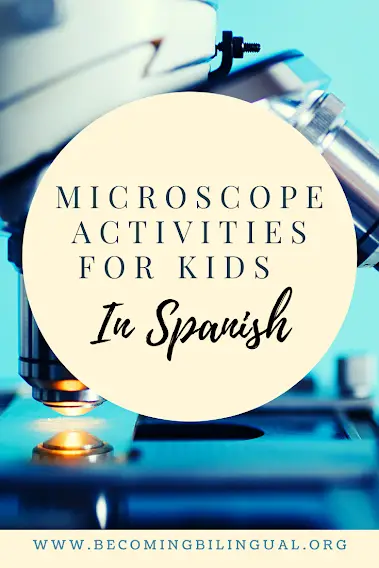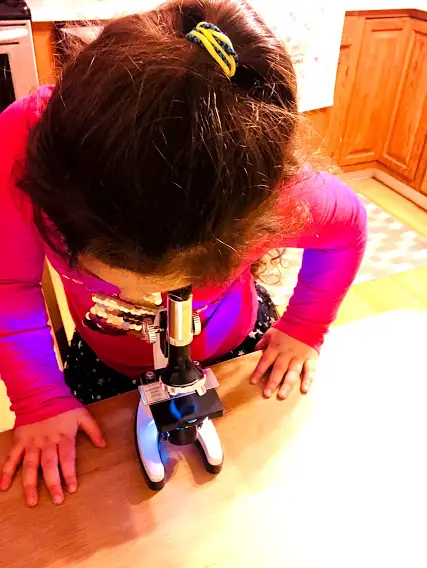Microscope Activities For Elementary Kids

My daughter has been increasingly interested in science and is often asking about germs (also maybe because we’re in a pandemic!!) In any case, we’ve had many conversations about germs, how they’re small and hard to see but that they’re still there. Since she’s been persistently curious about this topic, I decided to get her a microscope so that she could understand that there were some small things that can’t be seen normally, but that we can use science and technology to help us.
A good friend of mine suggested getting an optical microscope that had 1000x magnification. I did some research online and finally found a kids microscope that seemed user friendly and came with some materials so that we would be able to use it right away.
Taking the time to try new activities in Spanish is one of the ways that I’ve been keeping my daughter engaged with the Spanish language. I’ve found that when I introduce new concepts to her in Spanish first, it creates a ‘need’ for her to speak in Spanish. It also makes the activity special for us, since it’s something that we’re sharing in Spanish together and she hasn’t experienced it yet in English.
For more tips on promoting Spanish at home, check out this article!
The Challenges Of True Bilingualism In A Monolingual Culture
I’m going to share the microscope that we bought, the names for the parts of an optical microscope in Spanish and some of the activities that we’ve done with it so far.
This post contains affiliate links. If you click an affiliate link and make a purchase, I earn a small commission which supports this blog at no additional cost to you. Please see the Privacy Policy for details. Thank you for supporting me!
Table of Contents
The Microscope:
There are a lot of cool kid microscopes available and many that are more high tech and higher quality than the one that we purchased, but we picked this specific microscope for a few reasons.
The kit is relatively complete with things that a young child would be able to use an optical microscope for – slides and slide covers, vials, tweezers, and other various materials. It also comes with some pre-made slides of common items like “onion skin” and “apple” which are fun for kids to look at. There are also various experimental items in the kit such as brine shrimp and dyes as well as guides on how to use them, though we haven’t used all of these yet.
Most of the materials in the kit are made of plastic, so I’m not sure how they’ll stand up to repeated use by my daughter. I think that a more professional grade kit may have glass slides and slide covers as well as metal tweezers and scalpels. However, since we haven’t done much microscope work and I was looking for a beginning kit, this one seems to be working well for us.
Here’s the one that we started out with. It’s a good basic starter kit for kids and includes the necessary pieces to run a few basic experiments right away.
Parts Of The Microscope In Spanish:
One of the first things that we did with the kit was to label all of the parts in Spanish. I always try and make the Spanish activities that we do fun and engaging and I want to make sure that my daughter hears the Spanish vocabulary that goes along with whatever we’re doing.
We watched a video on the parts of an optical microscope and we worked on adding labels to our own so that we could practice talking about the different parts.
This is the link to a great video with Spanish audio that we used and that my daughter found interesting:
el brazo (the arm)
el base (the base)
un tubo (the tube/ eyepiece tube)
el lente ocular (the eyepiece)
la platina (the slide plate/ stage)
el agujero (the hole)
la pinza (the clip)
el tornillo macrometrico (the course adjustment knob)
el tornillo micrometrico (the fine adjustment knob)
el revolver (the turret/nosepiece)
los lentes/objectivos (the lenses)
la lampara/luz (the light)
Here are some simple Spanish phrases that you might use when you’re first working with the microscope with your child:
Enfocar (to focus)
Aumentar (to magnify)
los veces que aumenten (number of magnification)
la lamina (the slide)

Fun Microscope Activities That You Can Do With Kids:
1. Pre-Made Slides
The very first activity that we did was to play around with the pre-made slides that came with the set. Using the pre-made slides was a good way to get used to the vocabulary associated with the microscope. I could practice pointing out parts to my daughter and she could practice using them and trying them on her own.
Puedes poner una lamina en la platina? (Can you put a slide on the slide plate?)
Usa el tornillo para enfocar en la lamina. (Use the knob to focus on the slide.)
Since the slides were already made and the specimens are centered, they’re good to use to practice with focusing. The hardest part for my daughter was being able to bring the specimen from the slide into focus. With the pre-made slides, the specimen is centered and usually colored so that it’s easier to spot. They are also glued which means that accidental bumping won’t cause the slide cover to come off and misalign the image.
The pre-made slides have common things to see from common food items, to plants and animal parts that it’s easy to spend a lot of time exploring and talking about what you see. We’ve spent a lot of time on this activity, comparing what we’re seeing, talking about the shapes of what we’re looking at and just practicing basic microscope skills in general.
2. Pond Water
Once we became more proficient with the microscope and focusing on the specimens, we practiced making our own slides with the ones provided. My daughter really wanted to see what was in water so that she could see “germs” and other organisms that are alive in water sources.
We went for a walk to a small pond that is nearby and filled up one of the vials from the microscope kit with pond water. When we came home, we put a small drop of water onto a blank slide and added a slide cover.
Since there are so many live things in pond water, it was hard to focus and keep the organisms in the field of view for my daughter to see clearly, so she really had to do some of the search work herself, which was hard for her. Occasionally we would find things and then they’d move out of our field of vision and we wouldn’t be able to find them again. Also, since these aren’t pre-made slides and the specimens aren’t dyed, my daughter was unable to bring things into focus on her own.
While engaging, this kind of activity would be good for a child who is more independent with the microscope and has some more knowledge of moving and focusing the slide on their own.
Here are some common phrases that we used with this one:
Que ves? (What do you see?)
Como parece? (What does it look like?)
Puedes mover la lamina? (Can you move the slide?)
Here are some of the things that we observed in the pond water. It was challenging to take a picture of what we saw through the lens, so the images aren’t very clear.

On the left is my daughter using her microscope to view our home made slide of pond water. On the right is a picture of one of the things that we saw.

3. Making Your Own Slides
There are so many ways to use the microscope to explore the world around you! The instruction manual that comes with this kit goes through ways to make wet mount slides and dry mount slides.
We’ve had the most fun finding examples of things in nature and bringing them in to study. Since it’s spring and many things are just starting to bloom, we’ve brought in flower petals, leaves, shoots and other bits from nature to look at closely.
My daughter also received this awesome book that has been helpful in guiding her interests about things to explore. After reading a section on a particular topic, she will want to go out and try it for herself to compare the images from the book to what she sees under the microscope.
This book is actually also a kit to build your own microscope. We haven’t built this one yet, but we intend to. The images and information in the book are fabulous!
For more recommendations for nonfiction books in Spanish, check out this article:
Nonfiction Books In Spanish For Kids
Working on STEM and science activities at home is a great way to introduce new Spanish vocabulary and build awareness for different types of learning.
What STEM activities do you do with your kids? Share in the comments!
Happy Learning!
Don’t forget to subscribe here and get my latest posts and resources delivered directly to your inbox!


2 thoughts on “Microscope Activities For Elementary Kids”